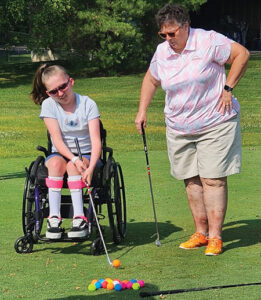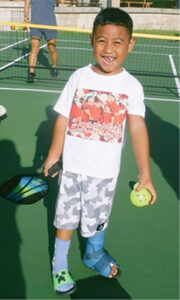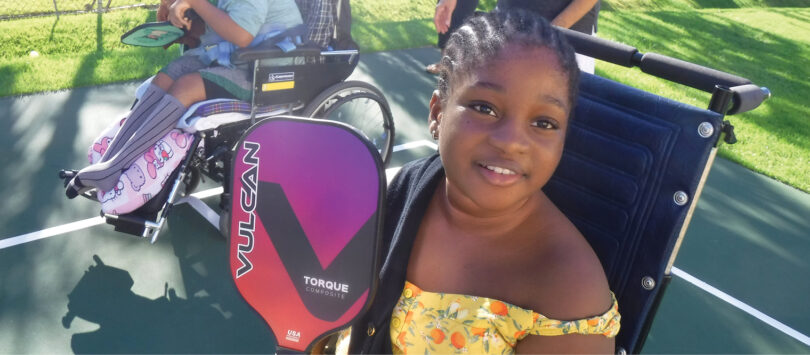Eric Smith, CP, a prosthetist at Shriners Children’s Northern California, has a story he tells about a 14-year-old patient, Micah, with a lower leg prosthesis.
One day, during a fitting, Micah mentioned that, just once, he wanted to beat his cousin in a race.
That’s interesting, thought Smith, a little surprised. “How old is your cousin?” he asked.
“He’s 7.”
Smith suddenly realized there was more he could be doing for his patients.
“I started wondering if function follows form here – whether your physical makeup determines who you decide you are and what you put your energy into,” Smith said. “Being an amputee can make it harder to be active. So, it would make sense if you tend to gravitate away from physical activity.”

Harley, 16, takes a swing at adaptive golf.
But children want to play and be active and physical. It’s in their nature.
The convention in pediatric prosthetics had been to give a child the simplest lower-leg prosthesis because it was easier to walk on during day-to-day activities. The child was moved up to a sportier model only if they expressed a desire.
But after his conversation with Micah, Smith decided to change this practice, and he has followed suit with many of his patients over the years. He gives children the option to choose a running prosthesis first; they can always “slow down” later. Smith fitted the 14-year-old with a more athletic, blade-like foot that “you could run a marathon on.”
One month later, Micah beat his cousin in a running contest.
“I listen, support and encourage kids to try new things, and then provide a prosthetic that helps them be active and is right for them,” said Smith. “Many times, they surprise themselves with their hidden abilities to move.”
Opportunities in motion
At one time, the need for individuals with physical limitations to be active was sometimes overlooked. But now, physicians and physical therapists stress the importance of appropriate physical activity for those with physical challenges.
The public’s interest in seeing people excel and compete was evidenced by the prominence of the Paralympic Games last summer. Shriners Children’s had nearly 20 former patients participate in the Paris Paralympics, including Hunter Woodhall, who won a gold medal in the 400M T62, and the youngest member of the U.S. wheelchair rugby team, 18-year-old Zion.
The AmSmithan Academy of Pediatrics recommends that children ages 6–17 get at least 60 minutes of moderate to vigorous physical activity daily. Doctors also recommend that kids do an activity that strengthens their bones and muscles at least three days a week. This is a recommendation that clinicians across Shriners Children’s take seriously.
Power of play
At Shriners Children’s Hawaiʻi, integrating play and physical activity into a child’s rehabilitation is an important component of ensuring their overall well-being, said Helene Freni-Rogers, CTRS, manager of recreation therapy. “Physical activity not only releases endorphins to lift a child’s mood, but it can also improve sleep, brain function, and weight control, and boost energy and self-esteem.”

Sean Paul, 7, smiles from the pickleball court.
With great weather year-round in Hawaiʻi, patients can enjoy the outdoor spaces around the hospital campus, including playing adaptive tennis and participating in the nationwide pickleball craze during weekly classes. The hospital also has a new junior tennis court and pickleball play area right on the grounds, where local pickleball club members volunteer to retrieve balls and engage in friendly games with the children.
In fact, national pickleball champion Steve Cole and his wife, Valerie, visited Shriners Children’s Hawaiʻi last year to offer a few pointers on the court. “It didn’t matter whether the kids could stand or used wheelchairs or crutches,” said Freni-Rogers. “They all participated, and their smiles were priceless!”
Creative outdoor programs
The recreational therapy department at Shriners Children’s Chicago also offers creative activities to help patients get outside and stay active as part of their care or rehabilitation, including monthly adaptive golf workshops and weekly garden-related fun in horticultural therapy.
Patients learn skills and techniques, as well as how golf can inspire. “Participating in adaptive golf improves balance, hand-eye coordination and endurance. It builds strength and can be enjoyed by anyone, regardless of their abilities,” said Darlene Kelly, director of recreational therapy at Shriners Children’s Chicago.
The program includes an adaptive golf cart, if needed, that features a rotating seat, allowing patients to swing from either a seated or semi-standing position based on their medical conditions.
Another way to enjoy the outdoors and stay active at Shriners Children’s Chicago is a weekly opportunity to dig in the dirt or create something beautiful during horticultural therapy programs in partnership with the Chicago Botanic Garden. The one-hour group activities allow patients to learn new skills or regain lost ones and may also enhance memory and cognitive abilities. In addition, gardening in the hospital’s backyard green spaces benefits patients by helping them improve coordination and balance.
Empowering kids to move
So, how does a parent encourage their child to be physically active?
Shriners Children’s caregivers say parents should be open-minded and look for opportunities. Their children may have to try many activities before they discover the one that excites and motivates them.
Given the right equipment and opportunities, children with physical challenges can explore new worlds of exercise, sports and competition. It’s all part of the Shriners Children’s mission to give kids the belief they can achieve their dreams and the tools they need to start reaching.





